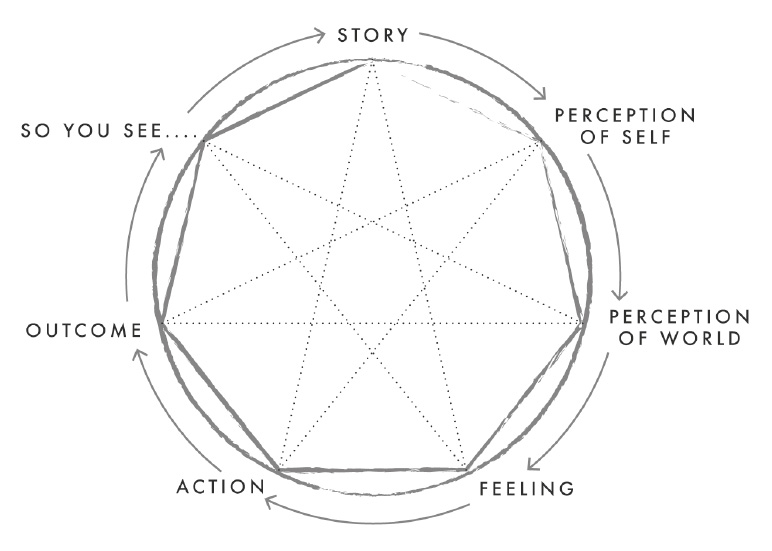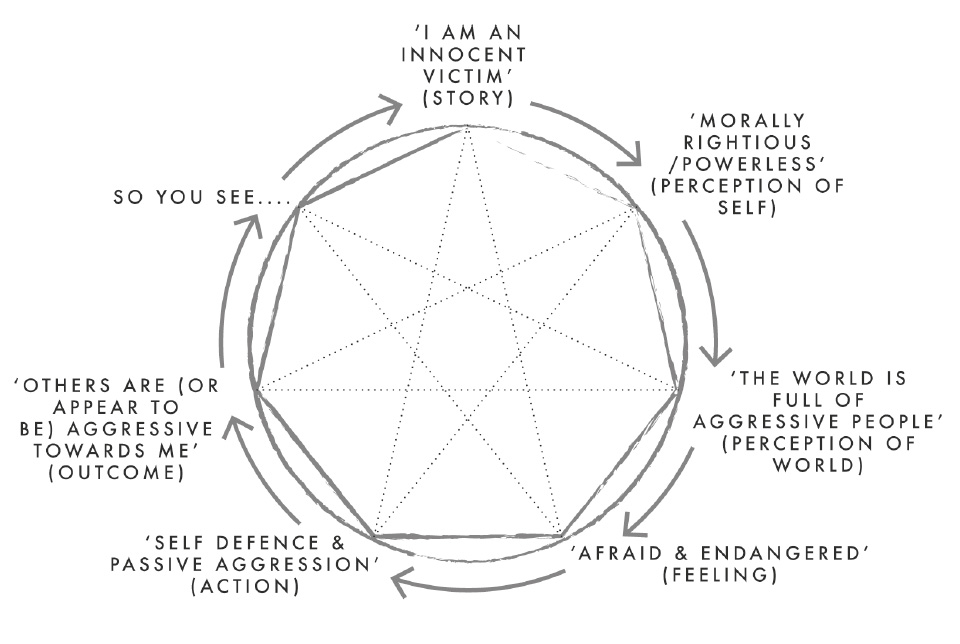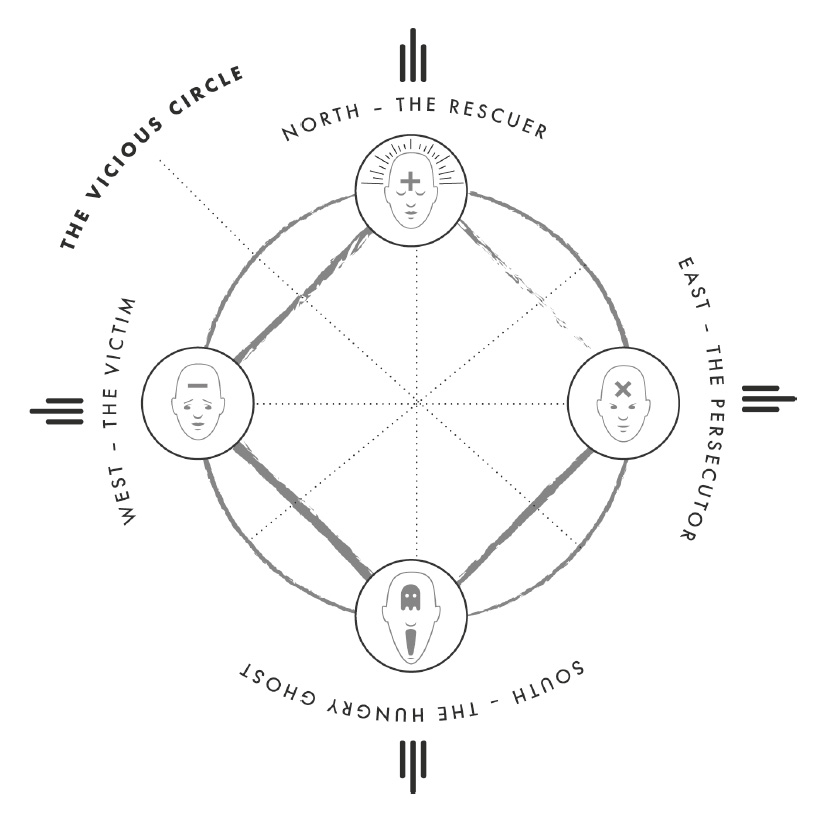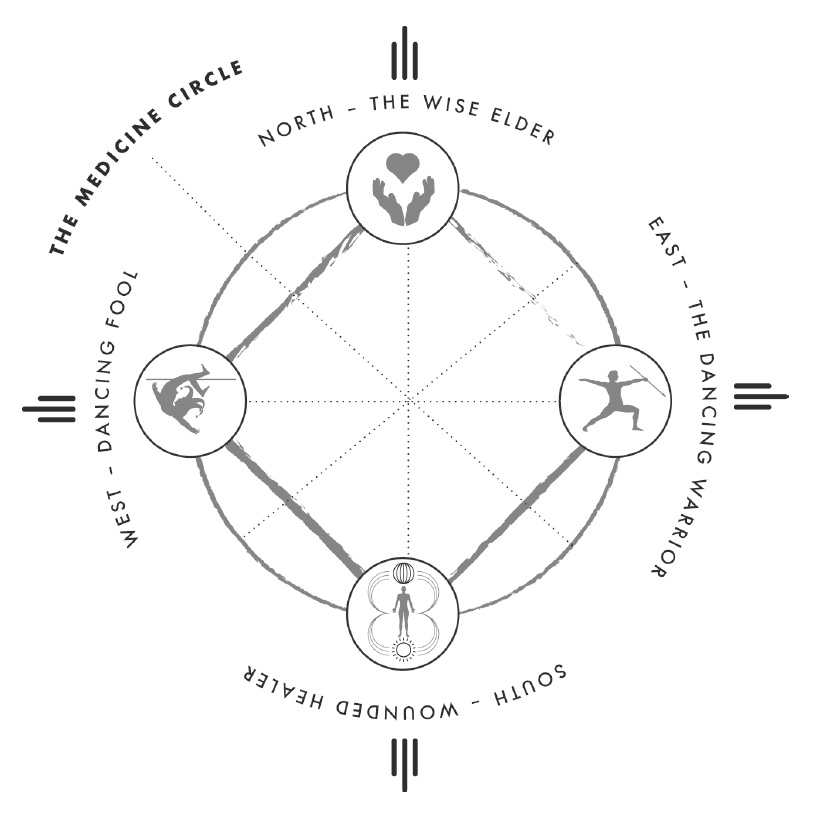

The Importance of Roles and Archetypes
‘Shamanic healing is a journey. It involves stepping out of our habitual roles, our conventional scripts, and improvising a dancing path.’
GABRIELLE ROTH
Vicious circles are self-perpetuating blame and counter-blame patterns which spiral deeper and deeper into negativity and destruction. They can happen within us and between us, and they frequently do. Our world is full of them and our media is full of the resulting aggravation.
Medicine circles are the complete opposite. They are rooted in positive stories and ‘win-win’ feedback loops that nourish and empower everyone involved. They are also self-perpetuating, but they create connection and hope, rather than destroying them.
Both circles begin with stories. Stories are the lens through which we perceive both ourselves and the world around us. Perceptions create feelings, and feelings motivate actions, and actions create outcomes that always reinforce the story we are telling. Shamans know that perceptions, like nature, are not fixed. And shamans are powerful people. If powerful people don’t dedicate themselves to questioning their perceptions, problems will never be far away. The more powerful the person, the bigger the impact of those problems. This goes for the Inner Shaman too. In order to learn to trust the power of the Inner Shaman, fierce, honest and kind self-enquiry is required on an ongoing basis.
A responsible shaman will do their best not to mistake their perception of reality for reality itself. As a healer, a shaman comes to understand that when our pain body (the shapes, patterns and undigested experience from past difficulties and trauma that live in the physicality of the body) is activated, we see the present through the lens of the past. When that happens, we imagine that what we hear is what is actually being said. When human beings are triggered, they go into whatever pattern they have learned in order to protect themselves, and humans are masters of the self-fulfilling prophecy. This time-devouring theatre of suffering is caused by not questioning our assumptions about who we are, who others are and what life is. It’s time for a change, and I want to show you how the Inner Shaman can help you to break out of some of the more common roles we play in these vicious circles and step out of the past into the present.
Here’s an example. Many of my ancestors were murdered in the holocaust and my great-grandparents were refugees. I have inherited much of great value from them and I have also inherited expectations about life that may or may not be true in the present. One is the story that I am an innocent victim. When I’m in that story, I perceive myself as morally righteous but powerless and I perceive the world as full of aggressive people out to get me. This leads to feeling afraid and in danger. The action that arises from this is to defend myself in any way I can. The more powerless I feel, the more passive my aggression will be. This leads to defending myself aggressively, which creates the expected outcome that people attack me. In turn, this ‘proves’ that my story is true. Since in this story my focus is on what is being done to me, I don’t notice my own aggression and so it seems to me that the obvious truth of the situation is once again that I am an innocent victim of other people’s bad behaviour. The perfect vicious circle!

Self-fulfilling prophecy map

Self-fulfilling prophecy specific example
Using the diagram above, see if you can track one of your own self-fulfilling prophecies. When I discovered this mechanism, I was both deeply sad and elated – sad because of all the precious life energy I had poured into this theatre piece, trying my best to get the ‘bad people’ to change their ways, i.e. doing the same thing and expecting different results, and elated because now I saw my part in the game, I knew I had the power to change it.
Getting to know your Inner Shaman’s resources and being willing to be creative with them makes it much more likely that you will be able to step out of the reactive response to the many triggers in life. In shamanism, we call these triggers allies, because if we are willing, they reveal the healing that is ours to do.
In neuroscience, picking out the proof for our own point of view to the exclusion of everything else is called inattentional blindness. For the Inner Shaman, recognizing the power our story has to change our perception is actually very good news. If our perception is driven by the meaning we give to our condition, fed by unowned emotion and held in place by our posture, then change any one of these and our perception can change too.
The more we use the tools we have available to embody and own our emotions, and the more willing we are to self-inspect, the more likely we are to discover the part we have played in any conflict we have experienced in life. Here’s an example from one of the Movement Medicine teachers we’ve trained of how the creativity of the Inner Shaman can help us do that:
It was my first Long Dance ceremony in 2010. I was just recovering from cancer and my last chemotherapy. I was tired, scared and without hair. At the age of 34, I knew not only cancer, but also various kinds of chronic illness, which included back pain that at times was debilitating, despite my young age.
I was carrying a strong story about not being able to be healthy and having very little energy. I remember that when we danced with our ancestors, I began a dialogue about being able to be free to experience more pleasure in my life. I could feel the long line of ancestors, especially women, behind me who hadn’t expressed their creative juice, their sexuality, their joy and their wild nature. They all seemed very contained, extremely serious and devoted to martyrdom.
I danced for them, feeling my sadness for their suffering, their losses and sacrifices. I told them I wanted to be free and to express my freedom for them too. I received their blessing and their strength, and it was as if a channel behind me had opened and I felt a change in my body.
I don’t know how to describe this without sounding woo-woo, but the back pain I had suffered for many years disappeared that night in an instant and has never returned.
LAURA VALENTI.
MOVEMENT MEDICINE TEACHER AND COACH
It is inevitable and necessary that as part of our journey towards self-knowledge we will spend time in the shadow lands of the human psyche. Knowing what it is to be disempowered, irresponsible and lost in a theatre of selves who are afraid, reactive and fixed humbles us and deepens genuine compassion. To recognize and accept these unowned, unknown parts of ourselves that make up our shadow makes it less likely that we will fall under their spell and project their self-fulfilling prophecies onto the world around us. This is the ongoing work of a lifetime and no amount of spiritual bypassing will help. To become who we are, we have to recognize, embrace and make choices about who we are not. The human ego is a fragile creature and it can cause untold damage when it has its hands on the steering wheel of our choices and actions.
For the Inner Shaman, life is an ongoing invitation to discover and take responsibility for who we are, both shadow and light. When I began working in the Middle East, I witnessed first-hand how all sides in the ongoing struggles there competed to be seen as the righteous victims of one another ’s bad behaviour. This affected me deeply and I began to see that this blame and counter-blame mode was at the heart of every conflict I witnessed or was involved in. I saw how often I perceived myself as the victim of other people’s unconsciousness and I understood how hard it was to see my own part in the creation of every single one of those difficulties. This led me to look at Stephen Karpman’s dynamic model of social interaction and conflict called the drama triangle. We’re going to make use of this work now from a shamanic perspective.
The drama triangle is made up of three well-known characters. Please enter Victim, Persecutor and Rescuer. In our work, we have found it helpful to name a fourth role, the Hungry Ghost. This expands Karpman’s drama triangle into a vicious circle whose momentum can devour enormous amounts of life energy. All the roles keep us away from the underlying emotions that they mask. Most of these emotions are rooted in past pain projected onto present circumstances. You will be likely to find, for example, that a Persecutor was once a Victim themselves. But unowned emotion leads to blaming, bullying, self-pity and our human predilection for maintaining the moral high ground by claiming to be the biggest Victim on the block. It is the foundation of our rigid certainties and dismissal of those we do not understand – dismissal that can so easily end in violence. It is present, too, in the spiritual malady of our addictions.
Wherever I travel, I see these roles being played out to devastating effect in our relationships with ourselves, each other and the world we live in. All of them support one another so as to remain convinced of their point of view. The Persecutor needs a Victim to blame. The Rescuer needs a Victim so they can keep the focus off themselves. The Victim needs both Rescuer and the Persecutor to keep them powerless and locked into the story that nothing can change. And the Hungry Ghost sits on a dark whirlpool of ancient emotion that feeds this vicious circle and keeps it turning at speed, sucking the life out of us and keeping us locked into our suffering.
Over the years, I’ve developed a way of working with these characters that leads into working with the shadow. In my experience, shadows can and do show up in all areas of life – money, sex, power, you name it. I’ve found it enormously fruitful and life-benefitting to actively seek out my own shadows. I’m confident you will too.
The Inner Shaman is a fine ally in this. Their love of the unknown and intrinsic creativity are invaluable at those inevitable times in life when the lights go out and we find ourselves stumbling in the dark. So it’s time now to ask your Inner Shaman to help you acknowledge and own how the roles of Victim, Persecutor, Rescuer and Hungry Ghost operate in your life as a vicious circle and collectively make up the central villain of the piece, the Charlatan or False Self, who is guaranteed to cause you and others pain.
As a way out of this circle, we will invoke and embody the four archetypal presences that make up the medicine circle: the Dancing Warrior, the Dancing Fool, the Wise Elder and the Wounded Healer. These four medicine archetypes are powerful allies who collectively empower our central archetype, the nemesis of the Charlatan, the Inner Shaman. Their mutually enhancing skills will give you the resources to see how the vicious circle operates, escape from it and step into the medicine circle. That is the intention of this practice.
 PRACTICE: FROM VICIOUS CIRCLE TO MEDICINE CIRCLE – CREATING NEW GROUND
PRACTICE: FROM VICIOUS CIRCLE TO MEDICINE CIRCLE – CREATING NEW GROUND 
You will need an hour for this practice.
As preparation for this powerful ritual, take some time to read the descriptions of the characters involved in the vicious circle (below) and the medicine circle and contemplate how they relate to your life.

The characters of the vicious circle
The Hungry Ghost is well known to most of us in one form or another. They play out our collective story that there is something missing inside us that can be described as a lack of both genuine nurturing (mothering) and loving discipline (fathering). Not knowing their own ground, the Hungry Ghost seeks to find it in whatever their hunger attaches to. Deep down, self-loathing, shame and a genuine lack of confidence in themselves and in life are the poisoned ground they stand on. They seek external approval and external solutions and at the same time, even if they are received, they will never be enough. The spiritual malady of addiction leads them on a downward spiral where the only respite is the fleeting pleasure of surrender to their addiction followed swiftly by a temporary zoning out from the suffering of life that only adds to the malaise on their return.
The Persecutor condemns and blames the Victim and has no problem letting them know it. They use their power to make sure that everyone realizes Victims are to blame for their own troubles. After all, they are bad people and, in the extreme, not even worthy members of the human race. Persecutors are righteously convinced that they are doing what’s best, and as long as it benefits them, they maintain the status quo, claiming it to be the natural order of things. But deep down, they are lonely, and behind their iron mask, they are secretly longing for love.
The Victim feels powerless to engage creatively with life. They take the moral high ground but play low status, and because they see themselves as weak, they don’t notice the effect they are having on others and their environment. They say: ‘Life is happening to me, just as it always has, just as it always will.’ They wear their past hurts as good reason not to take responsibility for themselves in the present. They justify their behaviour by staying identified with being powerless to change it in any way. Deep down, they are afraid of the fury they are sitting on, and though they depend on their Rescuer, resentment is never far away.
The Rescuer, the classic do-gooding enabler, works to keep the focus off themselves at all costs. They have convinced themselves that they can and must save Victims from Persecutors. They see exactly what needs to happen and they impose their view on the situation without being asked. In so doing, they manage both to enrage the Persecutor and keep the Victim feeling as powerless as ever. Deep down, they believe that if they give enough, eventually someone will love them back. A common phrase for Rescuers is: ‘After all I’ve done for you, this is what I get.’ From there, it’s only a short hop into any of the other roles in the vicious circle.

The characters of the medicine circle
The Wounded Healer, rooted in our connection to the Divine Mother and Divine Father, is hugely important to our wellbeing on every level. Whatever our experience with our own parents, the archetypal mama offers the warm holding, safety and acceptance vital to healthy beginnings, while the archetypal papa offers the clear, loving and boundaried guidance that gives us the safety and confidence to know where we are and grow into who we are. Whatever our personal history, we can all make a connection with the Divine Mother in the form of the Earth under our feet and the Divine Father in the form of the light of the sun. Together, they make up the archetype of the Wounded Healer, who can provide the nurturing and illumination we need to choose a path of self-acceptance and self-determination and break the chains of our addictions.
The Dancing Warrior uses the very same power that the Persecutor uses to stand up for and protect what matters most to them and to fight for what they hold most valuable. Without a doubt, owning who we are in this world and facing the unknown that is so much part of life in a body require the power and discipline of a Warrior. The Holy Grail for the Warrior is the power of choice. They don’t indulge the omnipotent fantasy that we create reality, but they understand that we do create our perception of reality. They provide the protection that we need to feel safe enough to recognize the inherent vulnerability of being human.
The Dancing Fool is creativity itself. Without past or future there is only the invitation of the present. Laughter and play are good medicine. Even more so is that quiet awe in the face of the improbable magnificence of existence that opens our eyes to the mystery and gives the Dancing Fool the power to fully embrace the opportunity of the moment. Their fascination with life allows them to see the ingredients on offer in any given situation as a rich palette of colour with which to create. Their imagination is boundless and their fear non-existent. Their innocence is their protection and the world their oyster.
The Wise Elder is the part of us who witnesses all of life’s happenings with the love, patience and depth born of long-term practice. They have been with us through all the ups and downs of life, sitting quietly at the centre of our heart, waiting for us to come and join them and ask them for guidance. They hold our inner wisdom. They take the long view that eldership brings. They know us well and they have that humorous twinkle in their eye and wrinkled smile that hint at golden secrets.
I am not these roles or their shadows. They operate through me. They are doing their best to protect me and, step by step, with all the help I can get, I am on my way to acknowledging them and releasing any hold they have over me.
Well done. That’s brave work. By stepping into these roles, you have begun the process of disidentifying from them.
It’s time now to work with the four medicine archetypes. These are powerful allies who collectively empower the central archetype, the nemesis of the Charlatan, the Inner Shaman.
Feel them inside you, shape them, animate them in movement, see how they strengthen the Inner Shaman’s way of embodying the power of choice (the Dancing Warrior), creativity (the Dancing Fool), love (the Wise Elder) and self-care and self-determination (the Wounded Healer). You may be more familiar with one and less familiar with another. Notice this as potential space to grow into as you deepen your relationship with them through practice. As you move from one archetype to another, take time to explore how their individual and collective strengths may help you to step out of the vicious circle and into the medicine circle.

Before we leave this chapter, I won’t be able to look my wife in the eye if I don’t confess that the characters in the vicious circle can still take me over from time to time. It’s never pretty. And the witness in me watches in amused, pained and loving disbelief as there I go again, pointing the finger of blame, rushing in to save someone from their own suffering, feeling weak and powerless to change anything and reaching outside myself to anything I can find to feed the insatiable hunger inside. However, I can no longer do this without that strong voice inside warning me to stop now before I do any damage!
It takes a lot of repetition to create an unhealthy habit and a lot of repetition to replace it with a healthy one. That’s the purpose of practising something – to get good at it. With practice and support, any of us can shift the balance of power in our psyche and spend more time in the best version of ourselves we can be.
I’ve found this kind of work has made me more sensitive to what is true for me and more able to express it. And shadow work, which we have begun with this ritual, can be extremely energizing and even enjoyable!
Congratulations. Your Inner Shaman now has four archetypes around them that will make them stronger and more resourced. You now have everything in place to complete your basket full of medicine with some shamanic alchemy. Time to transform a little lead into gold!